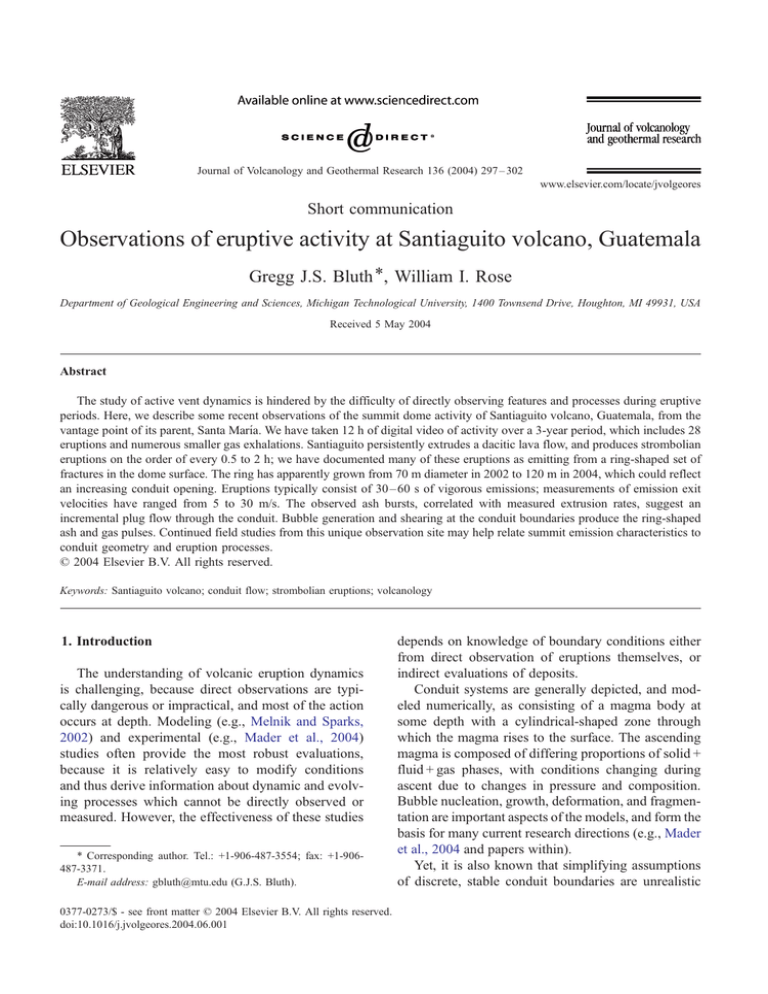
Journal of Volcanology and Geothermal Research 136 (2004) 297 – 302
www.elsevier.com/locate/jvolgeores
Short communication
Observations of eruptive activity at Santiaguito volcano, Guatemala
Gregg J.S. Bluth *, William I. Rose
Department of Geological Engineering and Sciences, Michigan Technological University, 1400 Townsend Drive, Houghton, MI 49931, USA
Received 5 May 2004
Abstract
The study of active vent dynamics is hindered by the difficulty of directly observing features and processes during eruptive
periods. Here, we describe some recent observations of the summit dome activity of Santiaguito volcano, Guatemala, from the
vantage point of its parent, Santa Marı́a. We have taken 12 h of digital video of activity over a 3-year period, which includes 28
eruptions and numerous smaller gas exhalations. Santiaguito persistently extrudes a dacitic lava flow, and produces strombolian
eruptions on the order of every 0.5 to 2 h; we have documented many of these eruptions as emitting from a ring-shaped set of
fractures in the dome surface. The ring has apparently grown from 70 m diameter in 2002 to 120 m in 2004, which could reflect
an increasing conduit opening. Eruptions typically consist of 30 – 60 s of vigorous emissions; measurements of emission exit
velocities have ranged from 5 to 30 m/s. The observed ash bursts, correlated with measured extrusion rates, suggest an
incremental plug flow through the conduit. Bubble generation and shearing at the conduit boundaries produce the ring-shaped
ash and gas pulses. Continued field studies from this unique observation site may help relate summit emission characteristics to
conduit geometry and eruption processes.
D 2004 Elsevier B.V. All rights reserved.
Keywords: Santiaguito volcano; conduit flow; strombolian eruptions; volcanology
1. Introduction
The understanding of volcanic eruption dynamics
is challenging, because direct observations are typically dangerous or impractical, and most of the action
occurs at depth. Modeling (e.g., Melnik and Sparks,
2002) and experimental (e.g., Mader et al., 2004)
studies often provide the most robust evaluations,
because it is relatively easy to modify conditions
and thus derive information about dynamic and evolving processes which cannot be directly observed or
measured. However, the effectiveness of these studies
* Corresponding author. Tel.: +1-906-487-3554; fax: +1-906487-3371.
E-mail address: gbluth@mtu.edu (G.J.S. Bluth).
0377-0273/$ - see front matter D 2004 Elsevier B.V. All rights reserved.
doi:10.1016/j.jvolgeores.2004.06.001
depends on knowledge of boundary conditions either
from direct observation of eruptions themselves, or
indirect evaluations of deposits.
Conduit systems are generally depicted, and modeled numerically, as consisting of a magma body at
some depth with a cylindrical-shaped zone through
which the magma rises to the surface. The ascending
magma is composed of differing proportions of solid +
fluid + gas phases, with conditions changing during
ascent due to changes in pressure and composition.
Bubble nucleation, growth, deformation, and fragmentation are important aspects of the models, and form the
basis for many current research directions (e.g., Mader
et al., 2004 and papers within).
Yet, it is also known that simplifying assumptions
of discrete, stable conduit boundaries are unrealistic
298
G.J.S. Bluth, W.I. Rose / Journal of Volcanology and Geothermal Research 136 (2004) 297–302
even for a single event, much less a series or cycle of
eruptions (Jaupart, 2000).
How can field observations help? There are many
potentially important field observations which could
be of use to current theoretical and laboratory studies
(e.g., Jaupart, 2000; Barmin et al., 2002; Melnik and
Sparks, 2002; Gonnermann and Manga, 2003; Mangan et al., 2004; Speiler et al., 2004): information
about the conduit shape and size; the stability of the
conduit during an eruption, and over longer time
periods; the ‘‘leakiness’’ of a conduit, with respect
to location of summit emissions; and the rates and
composition of emissions.
Few volcanoes allow regular, unobstructed observation of the summit activity during eruptive episodes. However, Santa Marı́a volcano (3772 m asl)
and the related Santiaguito dome (2500 m) are
uniquely situated to provide such a view. The devastating 1902 eruption of Santa Marı́a volcano erupted roughly 5– 10 km3 of dacite, removing much of
the southwestern portion of the previously symmetrical cone, but preserving the summit. A repose
period followed until 1922, when lava extrusion
began in the 1902 crater, forming the Santiaguito
dome at a point below the Santa Marı́a summit.
Extrusive activity has continued unsteadily since
1922. The actual location of active venting has
migrated somewhat from the central Caliente vent
over the past 80 years along three westward-trending
lateral vents. The present activity is focused on the
Caliente vent, active since 1977 (Rose, 1987). It
currently feeds a slowly advancing dacitic lava flow,
with strombolian eruptions every 0.5 to 2 h producing
a range of pyroclastic flows, block and ash flows, and
ashfalls. During the rainy season, these materials
deposited on Santiaguito’s flanks are remobilized as
lahars, often with destructive consequences for agriculture and transportation.
2. Methods
From the summit of Santa Maria, there is a clear
view to the Santiaguito dome, approximately 2.5 km
to the southwest. There are no recent topographic
maps of the region. Using a pair of airphotos taken in
January 2000 by the Bolivian Air Force and a stereoscope, we were able to measure the apparent distances
Table 1
Video archive of Santiaguito volcanic activity
Date
Observation
site
Observation
period
(local time)
Notes
January 11, 2002
Santa Marı́a
summit
El Brujo venta
0627 – 0823
Santa Marı́a
summit
Santa Marı́a
summit
0545 – 0851
5 eruptions,
13 exhalations
11 eruptions,
23 exhalations
6 eruptions,
7 exhalations
6 eruptions,
8 exhalations
January 9, 2003
January 11, 2003
January 15, 2004
0610 – 1037
0619 – 0915
a
Approximately 1.5 km W of the active Caliente vent, at about
150 m lower elevation; thus, there is no direct observation of the
dome surface from this location.
from Santa Maria to Santiaguito summits, and the
diameter of the Santiaguito summit crater. Comparing
these measurements to topographic maps gives a
summit crater diameter of approximately 180 m
( F 25 m).
We are developing an archive of digital video
observations of the crater and activity from our annual
field excursions (Bluth and Rose, 2002), beginning
from January 2002 (Table 1). The duration of the
video is constrained by light levels, with a 0600 local
time typically as a start, and until daily meteorological
cloud formation obscures the view (anywhere from
0900 to 1100). Activity generally consists of strombolian ash and steam eruptions, with minor gas
exhalations also occurring between events. The eruptions vary in timing, and often occur in pairs separated
by a few minutes repose. Fumaroles are present on the
upper flanks, and also occur in various and changing
locations within the summit crater.
3. Observations and discussion
Fig. 1 shows a sequence of images taken from a
typical Santiaguito eruption (chosen for its clarity).
This sequence of images illustrates several key
features.
3.1. ‘‘Ring’’-shaped emission pattern
Fig. 1a– d shows the emissions emanating from a
ring-shaped pattern of fractures. The emissions initiate
G.J.S. Bluth, W.I. Rose / Journal of Volcanology and Geothermal Research 136 (2004) 297–302
299
Fig. 1. (a – d) A time-sequence of a typical strombolian eruption at Santiaguito volcano, Guatemala. The photos are 1 s apart, and show the
emissions emanating from a ring-shaped pattern within the summit dome. The ring diameter is approximately 70 m. View is towards the south;
note the block-lava flow in the background.
at the circumference of the ring; overall, roughly 50%
of the observed eruptions displayed this pattern. The
eruptions are not purely confined to the ring; in some
larger events, explosions are initiated in the ring, then
migrate outwards. Note also that the emissions do not
occur simultaneously around the ring. We have observed emissions from virtually the whole summit
region during the set of eruptions, but never all at
once. The ring diameter in Fig. 1 is estimated to be 70
m. It appears that the diameter has increased over
time, with the 2003 ring measuring 90 –100 m in
diameter and the 2004 ring at about 120 m diameter.
This ring-shaped pattern of emissions is consistent
with the cartoon model of a cylindrical conduit,
perhaps with a conical widening at the summit.
Shear-induced magma fragmentation, releasing gases
particularly at the conduit wall boundaries has been
hypothesized as typical of open-system degassing
(e.g., Gonnermann and Manga, 2003). Monitoring
the size of the conduit may be important for understanding the explosivity or eruption potential in active
systems. Conduit diameter makes a significant different in eruption modeling studies; Barmin et al. (2002)
used a diameter of 20 m, while Gonnermann and
Manga (2003) and Mangan et al. (2004) assumed
diameters of 40 and 50 m, respectively. For comparison, during its highly active period in 1997, the
conduit at Soufriere Hills Volcano, Montserrat was
estimated at 50 –60 m diameter (Watts et al., 2002).
3.2. Eruption characteristics
The eruptions last for approximately 30– 60 s of
vigorous emissions, often followed by several minutes
of gas fuming. The main components of the events are
steam and fine ash. In one event, ballistics were
observed of approximately 1 m in diameter, with the
bombs landing down the flanks. Measurements of
300
G.J.S. Bluth, W.I. Rose / Journal of Volcanology and Geothermal Research 136 (2004) 297–302
emission speed range from 5 to 30 m/s, with most
occurring at about 10 m/s. The optimal sites for
making these exit velocity measurements were perpendicular to our viewing angle, to minimize distortion from the emissions traveling either towards or
away from our line of sight. Terminal plume heights
varied from several hundred meters above the vent, to
1200+ m (i.e., above eye level from our Santa Marı́a
vantage point). Studies of the eruption dynamics of
some of these events in 2003 were made by Johnson
et al. (2004).
Similar observations were recorded for the repetitive vulcanian eruptions of Soufriere Hills Volcano in
1997 (Druitt et al., 2002). Video monitoring suggested
exit velocities of 40 to 140 m/s, with typically slower
‘‘jets’’ at the start of the eruption, and increasing about
10 s later in the eruption.
3.3. Inter-eruption observations
Between eruptive episodes, periods of white,
steam emissions (termed ‘‘exhalations’’ here) can
be observed, either as discrete puffs (lasting tens of
seconds), or as long-lasting (up to 10 min) of small,
continuous emissions from various locations within
the summit crater. Constant degassing can be observed from numerous flank fumaroles, and occasionally through cracks in the summit surface. The
Fig. 2. Hypothetical scheme for the conduit processes at Santiaguito, based on surface observations. The plug flow extrusion of dacite comes
through a cylindrical conduit that moves incrementally. In this representation, we show the rate of movement that would be associated with an
average extrusion rate of 0.2 m3/s, through a 50-m diameter conduit. The stepwise vertical conduit movement is compensated by surface flow to
the south from the vent (into the page). The drawing here incorporates the incremental movement surfaces of the conduit (1, 2 and 3) which are
exaggerated in the vertical scale (they are only a few centimeters in dimension). The detail at lower right envisions bubble formation
preferentially along abundant slip surfaces near the conduit edge, which gives rise to the ring-shaped ash pulses. The set of fractures above the
conduit may widen in a funnel-like fashion as shown here.
G.J.S. Bluth, W.I. Rose / Journal of Volcanology and Geothermal Research 136 (2004) 297–302
flank fumaroles appear unaffected by any eruptive
activity (observed emitting even during eruptions),
but within the summit the emissions often change
locations, spontaneously initiating, then terminating
over time.
301
at the top of the feeder conduit and give us additional
clues as to the future activity of this persistently
erupting system.
Acknowledgements
3.4. A hypothetical conduit model
Fig. 2 depicts the incremental movement of plug
flow extrusion of dacite through a cylindrical conduit,
consistent with our video observations and measurements. Most of the shearing of dacite occurs near the
conduit walls where bubbles preferentially form,
which give rise to ash bursts. We assume a rate of
movement that would be associated with an average
extrusion rate of 0.2 m3/s through a conduit 50 m in
diameter. This is the low extrusion rate that prevails
most of the time at Santiaguito, based on field and
remote sensing observations (Harris et al., 2002,
2003). During accelerated extrusion periods, the rate
increases by as much as an order of magnitude
(Barmin et al., 2002). The stepwise vertical conduit
movement is resolved by the surface extrusion of a
block lava flow to the south (away in the schematic
view drawn).
4. Ongoing work
Santa Maria volcano provides an excellent perspective for observations of summit eruption dynamics at Santiaguito volcano. We have multiple years of
observations from which to study changes in emission geometry and timing, exit velocities, and many
other pertinent details of emissions types and fates,
and plan to continue these observations. We have
collected samples of ash which fell from activity at
the Caliente vent and lava samples from the ongoing
lava dome extrusions. It will be important to evaluate
our observations in detail over a multi-year period, in
order to link our eruption observations with ongoing
activity, for example, combining ring diameter evolution to extrusion rates and sulfur degassing fluxes.
Seismic data will also help in understanding of the
plug flow dynamics. The lava flow extrusion rates
have been declining during this time period (2002 –
2004); the observed increase in conduit diameter may
thus reflect a ‘‘sinking’’ of the cone-shaped structure
We thank our Guatemalan colleagues, Oto Matı́as
and Rudiger Escobar, for field support and discussions, and both the INSIVUMEH and CONRED
agencies for their continuing support of field
studies. Partial funding for this work came from
NSF Grant EAR 0118587 from the InternationalAmericas Program.
References
Barmin, A., Melnik, O., Sparks, R.S.J., 2002. Periodic behavior in
lava dome eruptions. Earth Planet. Sci. Lett. 199, 173 – 184.
Bluth, G.J.S., Rose, W.I., 2002. Collaborative studies target volcanic hazards in Central America, Eos Trans. AGU 83, 429,
434 – 435.
Druitt, T.H., Young, S.R., Baptie, B., Bonadonna, C., Calder, E.S.,
Clarke, A.B., Cole, P.D., Harford, C.L., Herd, R.A., Luckett, R.,
Ryan, G., Voight, B., 2002. Episodes of cyclic Vulcanian explosive activity with fountain collapse at Soufriere Hills Volcano,
Montserrat. Mem. Geol. Soc. London 21, 281 – 306.
Gonnermann, H.M., Manga, M., 2003. Explosive volcanism may
not be an inevitable consequence of magma fragmentation. Nature 426, 432 – 435.
Harris, A.J.L., Flynn, L.P., Matı́as, O., Rose, W.I., 2002. The thermal stealth flows of Santiaguito: implications for the cooling
and emplacement of dacitic block lava flows. Geol. Soc. Am.
Bull. 114, 533 – 546.
Harris, A.J.L., Rose, W.I., Flynn, L.P., 2003. Temporal trends in
lava dome extrusion at Santiaguito, 1922 – 2000. Bull. Volcanol.
65, 77 – 89.
Jaupart, C., 2000. Magma ascent at shallow levels. Encyclopedia of
Volcanology, Academic Press, pp. 237 – 245.
Johnson, J.B., Harris, A.J.L., Sahetepy-Engel, S.T.M., Escobar, R.,
Rose, W.I., 2004. Explosion dynamics of vertically directed
eruptions at Santiaguito Volcano, Guatemala. Geophys. Res.
Lett. 31, 06610, doi:10.1029/2003 GL 019079.
Mader, H.M., Manga, M.M., Koyaguchi, T., 2004. The role of
laboratory experiments in volcanology. J. Volcanol. Geotherm.
Res. 129, 1 – 5.
Mangan, M., Masti, L., Sisson, T., 2004. Gas evolution in eruptive
conduits: combining insights from high temperature and pressure decompression experiments with steady-state flow modeling. J. Volcanol. Geotherm. Res. 129, 23 – 36.
Melnik, O., Sparks, R.S.J., 2002. Modelling of conduit flow dynamics during explosive activity at Soufriere Hills Volcano,
Montserrat. Mem. Geol. Soc. London 21, 307 – 317.
302
G.J.S. Bluth, W.I. Rose / Journal of Volcanology and Geothermal Research 136 (2004) 297–302
Rose, W.I., 1987. Volcanic activity at Santiaguito volcano, 1976 –
1984. Spec. Pap. - Geol. Soc. Am. 212, 101 – 111.
Speiler, O., Dingwell, D.B., Alidibirov, M., 2004. Magma fragmentation speed: an experimental determination. J. Volcanol. Geotherm. Res. 129, 109 – 123.
Watts, R.B., Herd, R.A., Sparks, S.A., Young, S.R., 2002. Growth
patterns and emplacement of the andesitic lava dome at Soufriere Hills Volcano, Montserrat. Mem. Geol. Soc. London 21,
115 – 152.








